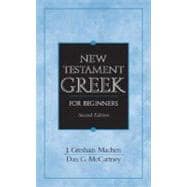
| Foreword | |
| Preface to the Revised Edition | |
| Preface to the Original Edition | |
| Introduction | |
| Abbreviations | |
| The Alphabet | |
| Accent | |
| Present Active Indicative | |
| The Second Declension | |
| The First Declension | |
| Adjectives of the First and Second Declension | |
| Masculine Nouns of the First Declension | |
| Personal Pronouns | |
| Adverbs | |
| Present Passive and Middle Indicative | |
| Imperfect Active Indicative | |
| Imperfect Middle and Passive Indicative | |
| Future Active and Middle Indicative | |
| First Aorist Active and Middle Indicative | |
| Second Aorist Active and Middle Indicative | |
| Aorist Passive Indicative | |
| The Third Declension | |
| Progressive Participles | |
| Attributive Participles | |
| Aorist Active and Middle Participles | |
| Aorist Passive Participle | |
| The Subjunctive Mood | |
| The Progressive and Aorist Infinitives | |
| Contracting Verbs | |
| Future and First Aorist Active and Middle of Liquid Verbs | |
| More Nouns of the Third Declension | |
| Additional Irregular Declensions | |
| Interrogative and Indefinite Pronouns | |
| The Imperative Mood | |
| The Perfect Tense | |
| Comparison of Adjectives | |
| Irregular Aorists, and the -mi Verb (part 1) | |
| Purpose Clauses, and -mi Verbs (part 2) | |
| -mi Verbs (part 3), and Conditions Contrary to Fact | |
| -mi Verbs (part 4),and the Optative Mood | |
| Paradigms | |
| Charts | |
| Glossary | |
| Greek-English Vocabulary | |
| English-Greek Vocabulary | |
| Frequency List (prepared by Professor Bruce M. Metzger) | |
| Section Number Correlations | |
| Index | |
| Table of Contents provided by Publisher. All Rights Reserved. |
The New copy of this book will include any supplemental materials advertised. Please check the title of the book to determine if it should include any access cards, study guides, lab manuals, CDs, etc.
The Used, Rental and eBook copies of this book are not guaranteed to include any supplemental materials. Typically, only the book itself is included. This is true even if the title states it includes any access cards, study guides, lab manuals, CDs, etc.